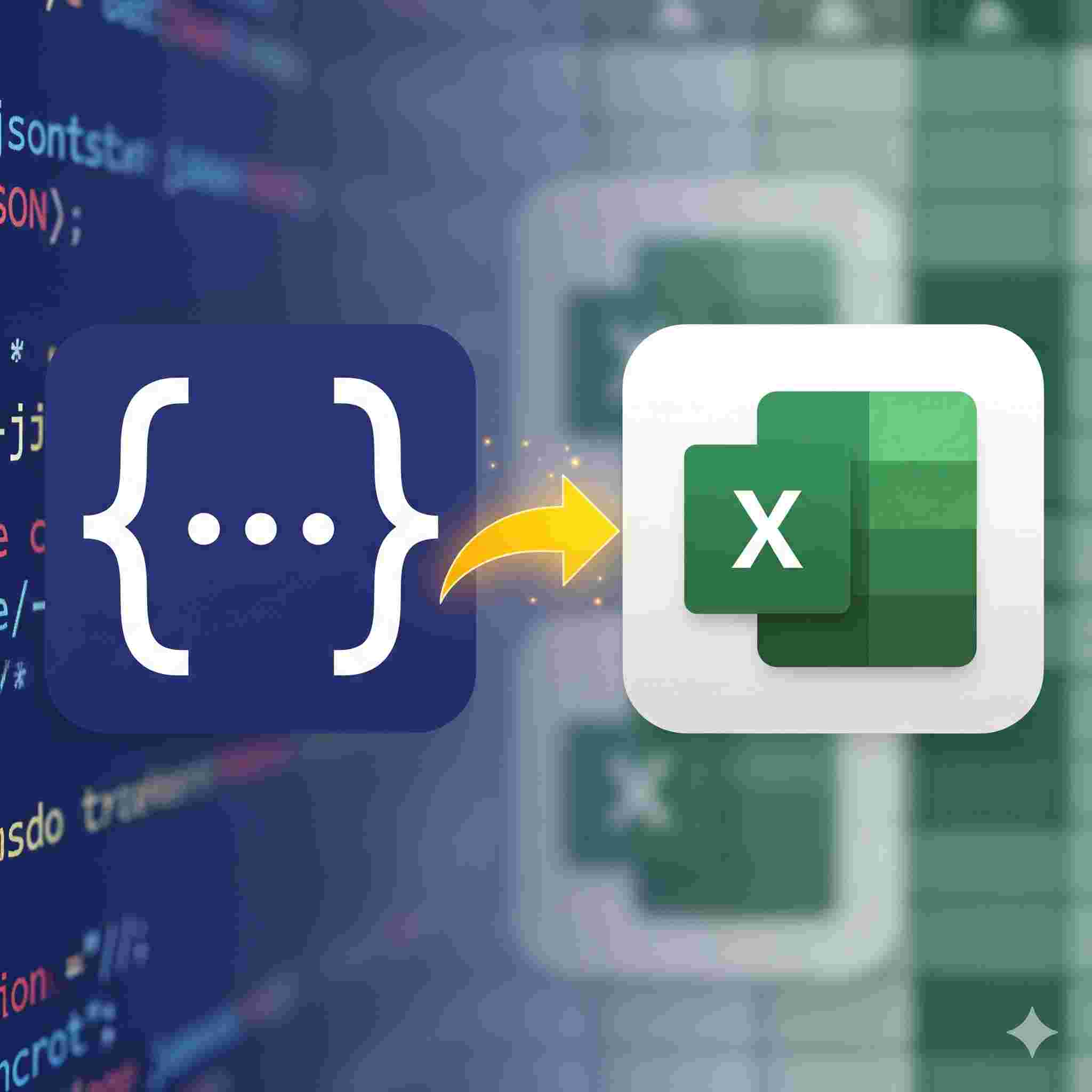JSON to Excel Converter
Easily convert your JSON data into Excel and CSV files.
Convert JSON to Excel (XLSX) – Free Online Converter

Looking for a quick and reliable way to convert JSON to Excel? You’re in the right place. This comprehensive guide covers everything you need to know—from basics to advanced methods—so you can seamlessly transform your JSON data into Excel spreadsheets (XLSX/CSV) for analysis, reporting, and business use.
Table of Contents
- Introduction
- What is JSON?
- What is Excel and Why It Matters?
- JSON vs Excel – Key Differences
- When Do You Need JSON to Excel Conversion?
- Methods to Convert JSON to Excel
- Step-by-Step Online Conversion Guide
- Advantages of Conversion
- Limitations & Challenges
- Best Free JSON to Excel Converters
- Use Cases
- How to Automate Conversion?
- Tips for Clean Excel Export
- FAQ
- Conclusion & CTA
Introduction
JSON (JavaScript Object Notation) is one of the most popular formats for data exchange in web applications and APIs. However, analyzing large JSON datasets directly can be difficult. That’s where Excel comes in. Excel (XLSX/CSV) is universally used for data organization, filtering, and visualization. Converting JSON to Excel bridges the gap between raw data and actionable insights.
What is JSON?
JSON stands for JavaScript Object Notation. It is a lightweight, text-based format used to store and exchange data. JSON is language-independent but easily parsed by most programming languages.
{ "name": "John Doe", "age": 30, "email": "john@example.com" }This format is widely used in APIs, databases, and configuration files.
What is Excel and Why It Matters?
Microsoft Excel is the world’s most widely used spreadsheet program. It allows users to manage, calculate, and visualize data. Excel formats like XLSX and CSV are compatible across industries. By converting JSON to Excel, you can leverage formulas, pivot tables, and charts to analyze data more effectively.
JSON vs Excel – Key Differences
- Structure: JSON is hierarchical (nested objects), while Excel is tabular (rows and columns).
- Readability: JSON is more machine-readable; Excel is more human-readable.
- Usage: JSON is popular in development; Excel is popular in business reporting.
When Do You Need JSON to Excel Conversion?
You need conversion when:
- Analyzing API output in Excel.
- Sharing data with non-technical team members.
- Importing data into BI tools.
- Cleaning datasets for reporting.
Methods to Convert JSON to Excel
1. Online Tools
Use free tools like JSON to CSV Converter. They are quick and user-friendly.
2. Microsoft Excel
Excel’s Power Query allows importing JSON directly. Navigate to Data → Get Data → From File → From JSON.
3. Python (pandas)
import pandas as pd # Load JSON with open('data.json') as f: df = pd.read_json(f) # Export to Excel df.to_excel('output.xlsx', index=False)4. Node.js / JavaScript
Use libraries like xlsx in Node.js to parse JSON and generate Excel files.
5. APIs
Automate conversion with APIs that handle JSON transformations and return Excel/CSV files.
Step-by-Step Online Conversion Guide
- Go to an online converter (e.g., ConvertCSV).
- Paste or upload your JSON file.
- Choose output format: Excel (XLSX/CSV).
- Click Convert.
- Download the Excel file.
Need instant conversion?
Try our Free JSON to Excel Tool now and get your spreadsheet in seconds.
Advantages of JSON to Excel Conversion
- Easy visualization with charts and graphs.
- Quick filtering and sorting.
- Compatible with BI tools.
- Non-technical users can understand the data.
Limitations & Challenges
- Nested JSON objects may not flatten perfectly.
- Data loss risk during improper parsing.
- Large files may slow down Excel.
Best Free JSON to Excel Converters
| Tool | Formats | Features |
|---|---|---|
| JSON-CSV.com | CSV/XLSX | Simple, fast |
Use Cases
- Developers: Debug API responses in Excel.
- Data Analysts: Clean JSON datasets for analysis.
- Businesses: Import customer/order data.
- Students: Convert open data into Excel projects.
How to Automate Conversion?
Automation is possible with scripts (Python, Node.js) or cloud workflows (Zapier, Integromat). For example, schedule a Python script to fetch JSON from an API daily and save it as Excel.
Tips for Clean Excel Export
- Flatten nested JSON objects.
- Ensure UTF-8 encoding.
- Validate JSON before conversion.
- Remove unnecessary attributes.
Frequently Asked Questions (FAQ)
1. Is JSON to Excel conversion free?
Yes, most online tools are free for small files.
2. Can I convert JSON to CSV instead of Excel?
Yes, CSV is another common format supported by converters.
3. Does Excel natively support JSON?
Yes, with Power Query you can import JSON directly.
4. What if my JSON has nested objects?
You may need to flatten it before exporting to Excel.
5. Is it safe to upload JSON files online?
Trusted converters are safe, but avoid uploading sensitive data.
6. Can I automate the process?
Yes, using scripts or APIs.
7. Which is better: CSV or XLSX?
XLSX supports formulas and formatting; CSV is lightweight and simple.
8. Can Google Sheets handle JSON?
Yes, with Apps Script or add-ons, you can import JSON into Google Sheets.
Conclusion
Converting JSON to Excel empowers you to analyze, visualize, and share data effectively. Whether you use online tools, Excel’s built-in features, or programming languages like Python, the process is simple and powerful.
Ready to try? Use our Free JSON to Excel Converter today and simplify your workflow!
